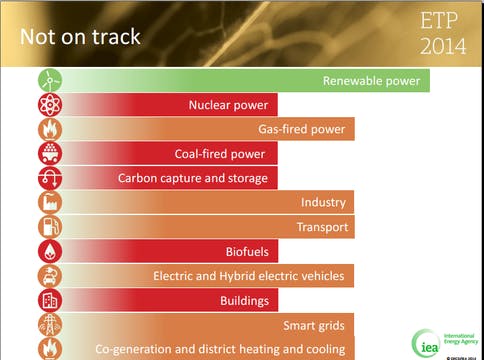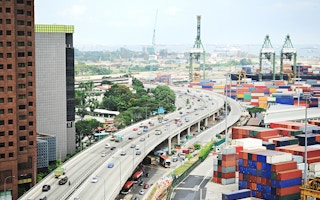The Singapore government is investing $100 million into research on how to make buildings and data centres here more energy efficient.
To continue reading, subscribe to Eco‑Business.
There's something for everyone. We offer a range of subscription plans.
- Access our stories and receive our Insights Weekly newsletter with the free EB Member plan.
- Unlock unlimited access to our content and archive with EB Circle.
- Publish your content with EB Premium.
The money will be used to establish research hubs for building energy efficiency and green data centres, managed by the Building and Construction Authority and the Infocomm Development Authority respectively.
This initiative was announced by Yong Ying-I, permanent secretary for national research and development, at the Energy TechRoadmap Symposium held at the Suntec City Convention Centre on Wednesday. About 700 guests attended the event.
Singapore’s National Climate Change Secretariat and the National Research Foundation also released five technology roadmaps which outline the government’s plans to promote certain technologies to reduce country’s energy demand and carbon dioxide emissions.
The plans were developed as part of the government’s Energy National Innovation Challenge set up in 2011 to identify energy solutions that were cost-competitive and could be implemented within 20 years.
These blueprints, jointly developed by experts from the government, academia and industry, cover five key areas of technology development which have potential to yield clean energy and energy efficiency solutions. They are: solar energy, green data centres, carbon capture technology, and energy efficiency in buildings and energy.
Yong noted that these roadmaps were “one of the critical tools in [Singapore’s] strategy to understand global technological trends and inform the research and development priorities for Singapore to develop the energy solutions we need for tomorrow”.
The five roadmaps
- Solar: Solar energy will play an increasingly central role in Singapore’s electricity generation as PV technology becomes more efficient. Singapore has a competitive edge in the areas of developing solutions tailored to tropical climates and the limited availability of space.
- Green Data Centres: There are strong growth prospects for Singapore’s data centre industry, which is already an Asian hub. The roadmap assessed a broad range of technology to improve the energy efficiency of the hardware and software used in data centres.
- Building energy efficiency: There were four key areas areas where technology could be used to improve energy efficiency in buildings, including building management and information systems and air conditioning and mechanical ventilation.
- Industry energy efficiency: The industry sector, which accounts for more than half of Singapore’s energy demand, can be made more energy efficient through implementing new technologies in the petroleum, petrochemical, semiconductor and pharmaceutical sectors, according to an interim update on the ongoing roadmap for industry energy efficiency.
- Carbon capture, storage and utilisation (CCS/U): CCS/U from stationary sources such as power stations is a potential technology which can help reduce carbon emissions. Carbon capture storage is currently not a viable option in Singapore due to its limited land area and the low concentration of carbon dioxide in industrial emissions. However, there are opportunities in carbon capture utilisation, where captured carbon is processed into new products.
Michael Quah, professor at the National University of Singapore and one of the main contributors to the roadmap noted that CCS/U was unique in its focus on ways to mitigate the carbon that had already been emitted, while the rest of the roadmaps focused on preventing emissions.
The roadmap identified a broad range of carbon capture utilisation options, including carbonating drinks in the food and beverage sector, manufacturing industrial chemicals such as formic acid and urea, and making construction materials such as polycarbonates and silica sand.
Experts noted that more research and development was needed to make this an economically viable and energy efficient strategy to adopt at a large scale.
In addition to these five roadmaps, Yong also announced that that there were two more in the pipeline for electric vehicles and solid waste management.
“The roadmaps will help all stakeholders evaluate their business options and direct their investments, sharpen their R&D strategies, as well as develop policy levers to facilitate quicker translate of these technologies into deployable solutions,” she added.
Global community lagging on energy reduction targets: IEA
“
The roadmaps will help all stakeholders evaluate their business options and direct their investments, sharpen their R&D strategies, as well as develop policy levers to facilitate quicker translate of these technologies into deployable solutions
Yong Ying-I, permanent secretary for national research and development
While Singapore has shown a strong commitment to reduce the city state’s greenhouse gas emissions, the International Energy Agency (IEA) shared in a keynote address that the global community was severely lagging behind on energy reduction targets.
Cecilia Tam, head of the IEA’s energy demand technology unit, said that some technological solutions had been identified by IEA to reduce enough greenhouse gas emissions to prevent global temperatures from rising more than 2°C beyond pre-industrial levels by 2050. This is the limit recommended by the Intergovernmental Panel on Climate Change (IPCC) to avoid dangerous impacts of climate change on humans.
These solutions looked at ways to reduce carbon dioxide emissions through various means, including scaling up renewable power, adopting biofuels, making buildings more energy efficient, carbon capture and storage, and smart grids.
However, out of 12 identified technologies, only one – renewable power – was being adopted and implemented at a scale and pace that was required to stay below the 2°C limit.

The International Energy Agency revealed that several areas of energy technology are not being deployed rapidly enough to meet global emissions reduction targets. Image: International Energy Agency
Tam shared said that among the areas that had yet to catch up, energy efficiency in industry and transport, along with smart grids, were the most promising.
“Different technologies struggle for different reasons in terms of reaching the levels we need to be at to meet the 2°C limit,” she told Eco-Business.
“One of the best ways to get these back on track is to have clear policy commitments from countries to address this serious climate change problem,” she added.

















